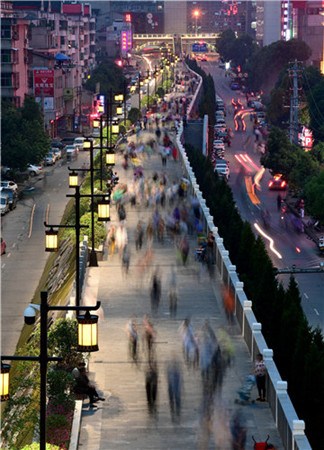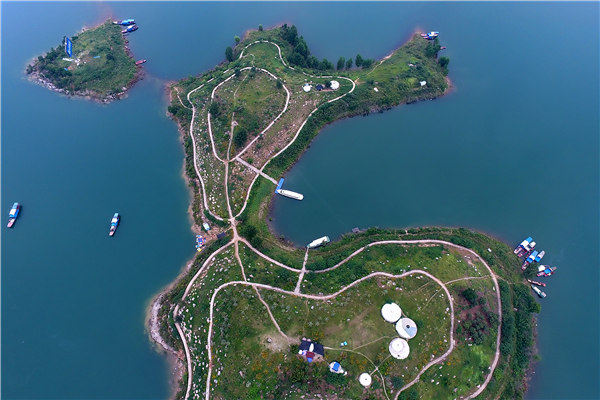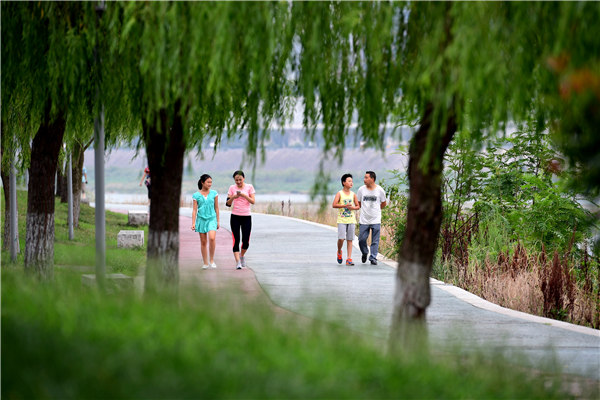| « Google to open AI center in Beijing | China increasingly attractive to foreign professionals » |
Water diversion project drives environmental improvements and provides new jobs for locals

Residents stroll through the streets of Ankang city, Shaanxi province.
Tuesday marks the third anniversary of the start of operations of the central route of the South-to-North Water Diversion Project, a massive infrastructure program designed to transport water from the south of the country to the arid northern regions via three separate channels.
So far, more than 10 billion cubic meters of water have been carried to North China via the central route, benefiting more than 53 million people.
The environmental improvements that have resulted from protection efforts in the regions that supply the water?the provinces of Henan, Hubei and Shaanxi?have attracted investment and brought new job opportunities in green industries, including tourism and ecological agriculture, benefiting people in the areas that supply the water.
Xia Qinghua is one of them. The 43-year-old was employed in a small toy factory in Shenzhen, Guangdong province, for 12 years before he returned to his home, Chenjiawan, a village in Hubei's Shiyan city, in June.
He had long wanted to return, but was prevented by a shortage of jobs. However, the situation changed after Hubei Beidouxing Eco-agriculture and Forestry Co began investing in the area in 2014, lured by the cleaner environment.
"Great improvements have happened to the environment in my hometown. When I left at age 17, I had never seen an egret. Now, there are birds everywhere. They are beautiful," he said.
Though he earned more than 5,000 yuan ($756) a month in Shenzhen, Xia often had to work until 11 pm.
"The salary was good, but I felt lonely and helpless because I had no family around me," he said.
In 2011, he attempted to return to Chenjiawan, but the move wasn't successful. "There weren't many business opportunities in the poverty-stricken area at the time," he said. Xia had spent 50,000 yuan on a small truck and started a transportation business, but he lost his investment and was 20,000 yuan in debt after a year, so he was forced to return to Shenzhen.
After that, he only returned home once a year, for the Spring Festival holiday, and leaving his family was always a tearful affair.
"I remember very clearly leaving home on the evening of the fifth day of the Lunar New Year in 2013. My wife, my daughter and I cried in each other's arms. They all didn't want me to go," he recalled, tears glinting in his eyes.
Now, he works in the warehouse at a farm operated by Hubei Beidouxing, making about 2,000 yuan a month. Even though he earns less than he did in Shenzhen, Xia is much happier because he is close to his family and can care for his 70-year-old father, who is unwell. He supplements his income by leasing 0.5 hectares of farmland to Hubei Beidouxing, which brings in an extra 4,000 yuan a year.

The Danjiangkou Reservoir in Shiyan, Hubei province, is a source area for the South-to-North Water Diversion Project.
Li Wei, head of the farm, said the company rents 200 hectares of land from residents of three nearby villages, which have a combined population of about 5,000. While 500 villagers work on the farm full time, a further 2,000 are employed seasonally every year.
So far, the company has invested 280 million yuan in the farm, which has been in operation since 2014. However, the enterprise only became profitable this year; Hubei Beidouxing made more than 2 million yuan from the sale of fruits and flowers, and the farm attracts a steady flow of visitors who come to view the blossoms on the trees and pick fruit, he said.
The company has bought a number of vehicles to provide free transportation for sightseers. "The purpose of offering these services is not to make money. Instead, we hope to attract tourists and create business opportunities for people in local villages," Li added.
Some local residents have also started providing services in their homes, such as restaurants and guest rooms. In response to the rise in the number of visitors, Xia plans to provide tourist services too.
The most recent data is not yet available, but the Office of the South-to-North Water Diversion Project said that between 2011 and 2015 the central government invested more than 17 billion yuan in environmental protection measures in the area that supplies the central route.
Beijing and Tianjin, two of the prime beneficiaries of the project, have also invested a combined 2.3 billion yuan in 650 projects, including a number designed to protect the environment and develop ecological industries, such as eco-agriculture and tourism. The municipalities have also mobilized local businesses to invest 88 billion yuan in 118 projects.

People stroll on a walking path near an embankment of Hanjiang River in Ankang, Shaanxi province.
Marketing opportunities
Last year, Chen Guosheng returned to his hometown of Shiquan county in Ankang city, Shaanxi, which is also located in the source area for the water diversion project.
The entrepreneur was prompted to return by the rise in the number of business opportunities resulting from the improvement to the local environment.
"The improvements have resulted in a lot of high-quality farm produce, but the local farmers don't know how to market or sell the goods," he said.
In response, Chen's company, Shaanxi Baren Tourism and Culture Co, is building marketing channels, and has invested 20 million yuan to transform Zhongba, a small village, into a business hub.
His plan is that tourists will be able to visit for sightseeing and also learn how to make local delicacies, including tofu and cooking oil, using local farm produce and traditional facilities and methods. A trial has been in operation since Oct 1, while the village is being redeveloped.
Chen also rents 67 hectares of land, which he has turned into a tea plantation. The leaves grown on the plantation are highly rated by a tea merchant in Guangdong province, who has ordered a continuous supply.
Business opportunities are also being nurtured in Madeng township, Nanyang city, Henan, via a 1,667-hectare forestry project intended to restore desertified land in a mountainous area.
Two scenic spots are the township's main tourist attractions, generating annual revenue of 35 million yuan. Now, the local government is using the forestry project, which has attracted investment of 82 million yuan, to widen the area's appeal to visitors.
Cherry and Chinese cherry apple trees will be planted along roadsides to create attractive scenery, while pomegranates and walnuts will be cultivated to allow tourists to pick their own fruit, said Zhou Yushan, head of the Madeng government.
In 2009, the per capita income in the township was about 3,000 yuan, but this year the figure is double that thanks to the tourism boom. There are now more than 100 "farm resorts" in the township, according to Zhou.
"The environmental improvements are bringing more opportunities for the development of tourism. All nine registered impoverished villages in the township will be lifted out of poverty by the end of the year," he said.